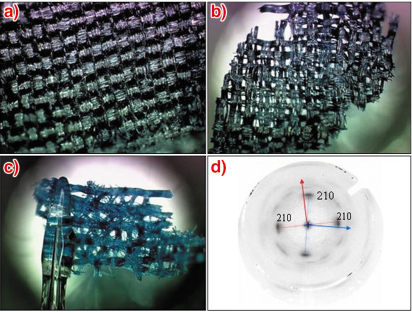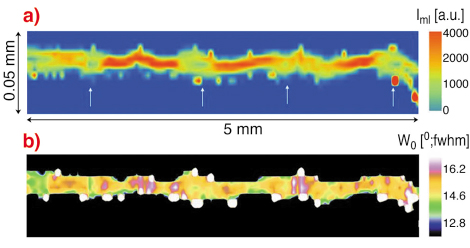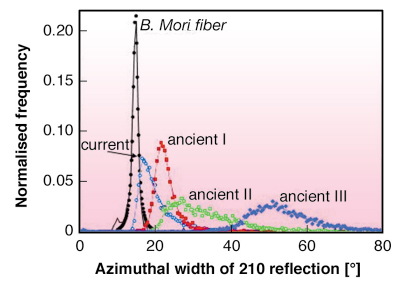- Home
- Users & Science
- Scientific Documentation
- ESRF Highlights
- ESRF Highlights 2006
- Soft Condensed Matter
- Characterising the decay of ancient silk fabrics by microbeam synchrotron radiation diffraction
Characterising the decay of ancient silk fabrics by microbeam synchrotron radiation diffraction
Understanding and quantifying the decay process of silks is of prime importance for the restoration and conservation of ancient silk fabrics. We have been using synchrotron radiation microdiffraction at beamline ID13 to characterise the fibre microstructure and the overall state of the fabric coming from the Famen temple, China. The temple is situated 120 km west of the ancient Chinese capital Xi’an and is one of China’s most important buddhistic sanctuaries. The silk fabrics were part of a treasure once laid down by the T’ang dynasty (618-907 AD) emperors as a gift to the temple [1]. Three plain-weave silk fabrics were selected according to their loss of structural integrity, which was assumed to reflect different states of degradation.
 |
|
Fig. 56: a) current plain-weave silk fabric; b) and c) ancient silk fabrics showing different degrees of decay; d) diffraction pattern from fabric showing 210 reflections of two nearly orthogonal fibres hit by the beam. |
The decay of a silk fabric is a complex process starting at the level of the fibres and propagating through the fabric until the destruction of its morphology. Decay of the amorphous protein chain fraction in a fibre will reduce the network of amorphous chains connecting the crystalline domains and consequently broadens their axial orientation distribution. The azimuthal width of the 210 ß-sheet reflection (Figure 56d) allows quantification of this orientation distribution and is therefore a sensitive indicator for the state of decay. We have mapped extended areas of a current silk fabric and ancient fabrics at different levels of decay (Figure 56 a-c) using a beam of about 1 micrometre in size and recorded a diffraction pattern at every position. For comparison, a single Bombyx mori thread (2 fibres) was mapped in the same way. The extracted 210 reflections allow the creation of a composite image as shown in Figure 57 for the Bombyx mori thread. The integrated intensity is proportional to the crystalline fraction (Figure 57a) and the plot of the azimuthal width reflects variation in orientation distribution across the thread (Figure 57b).
 |
|
Fig. 57: a) composite plot of the 210-reflection intensity across a Bombyx mori thread. Size of individual pixels: 2.5 x 50 µm2. The thread was cylindrically twisted so that the two individual fibres can only be seen at the positions marked by white arrows; b) composite plot of the azimuthal width (W0) of the 210 reflection across the thread. The white spots correspond to fwhm values outside of the colour scale, which are due to low counting statistics. |
A more quantitative analysis of the state of decay can be based on the histogram of azimuthal width distribution for the different samples (Figure 58). The histogram peak was found to be symmetric for the silk thread and asymmetric for the fabrics. The asymmetry suggests a convolution of a symmetric microscopic term due to the orientation distribution of the fibres and a macroscopic term introducing tails due to the angular spread of fibres sampled along the beam path. An increasing decay broadens the symmetric term peak and shifts the peak centre to larger values, presumably due to a loss of the connecting amorphous network. The break up of the fibre network due to decay processes can explain the tails of the histograms.
 |
|
Fig. 58: Experimental data (symbols) and fitted functions (solid lines) of histograms of 210-width distribution. The frequencies of each sample-series have been normalised to the sum of frequencies. |
The current results suggest that the microscopic decay process in the fibres starts by a loss of amorphous protein chains. At a subsequent stage of ageing, cleavage proceeds into the fibrils and the silk fibres break up into even smaller fragments. Restorative action requires probably that the nanofibrillar morphology remains largely intact and can be embedded in an artificial random polymer chain matrix.
References
[1] S. Greiff, H. Kutzke, S. Lahlil, C. Riekel, P. Wyeth, in AHRC Research Centre for Textile Conservation and Textile Studies First Annual Conference (2004). Winchester: Archetype Publications Ltd, London, UK.
Principal Publication and Authors
A.C. Hermes (a), R.J. Davies (a), S. Greiff (b), H. Kutzke (c), S. Lahlil (d), P. Wyeth (d), C. Riekel (a), Biomacromolecules 7(3), 777-783 (2006).
(a) ESRF
(b) Römisch Germanisches Zentralmuseum, Mainz (Germany)
(c) University of Applied Science Cologne, Köln (Germany)
(d) Textile Conservation Centre, University of Southampton Winchester Campus, Winchester (UK)



